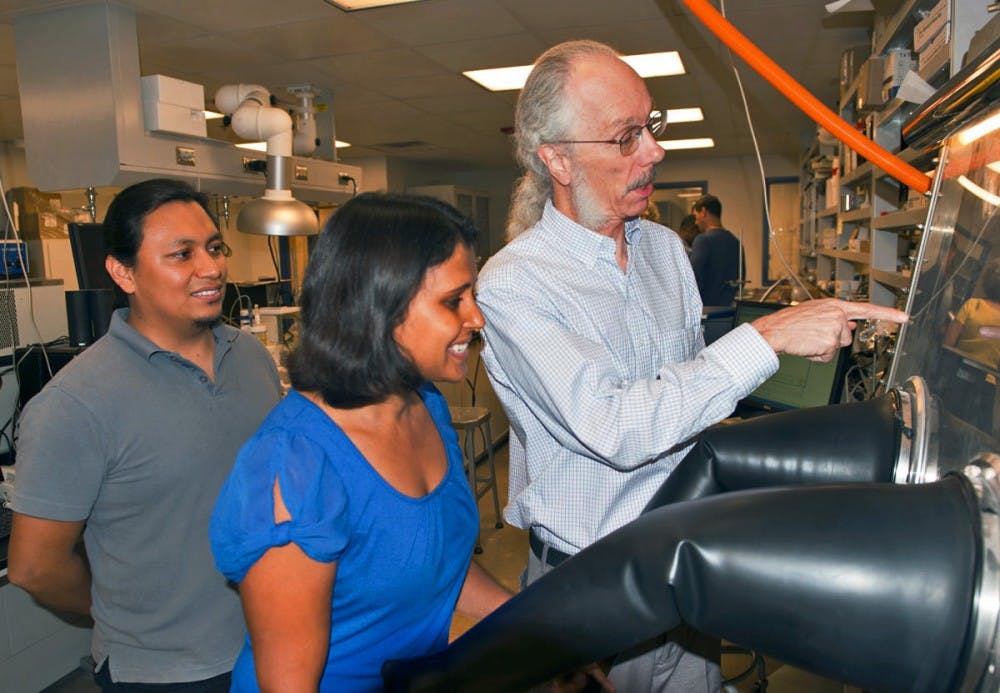 ASU researchers Dan Buttry (right) and coworkers Helme Castro (left) and Poonam Singh work in the lab.
ASU researchers Dan Buttry (right) and coworkers Helme Castro (left) and Poonam Singh work in the lab.
(Photo Courtesy of ASU News/Photo by Mary Zhu)
Carbon dioxide poses a threat to contemporary global climates, and most environmental advocates work to combat it by planting trees, which consume carbon dioxide in order to fuel life processes.
However, a team of scientists at ASU, lead by Department of Chemistry and Biochemistry Chair Daniel Buttry, is working on another way to reduce the effects of carbon emissions.
Buttry and his team are working on an innovative method of carbon capture that will improve the way power plants separate carbon from other emissions in order to contain it, making it more efficient and less expensive to do so.
“Working on this project is terrific,” he said. “It’s giving me the opportunity to work on something that I find interesting and important.”
He said the new technology could help combat the root cause of global warning.
The accumulation of insulating greenhouse gasses in the Earth’s atmosphere is the culprit most modern climate scientists believe to be directly responsible for global climate change, and humans contribute to the emission of these gasses through energy production and use at power plants, at manufacturing facilities and in automobiles.
Humans emitted more than 6,500 million metric tons — each million metric tons being the equivalent of approximately 2.2 billion pounds — of greenhouse gasses in the U.S. in 2012, according to EPA statistics. Carbon dioxide accounted for 82 percent of all greenhouse house gas emissions.
Buttry said the device he and his colleagues are creating could reduce this number.
Their device would look to the unfamiliar eye exactly like the air filters used in power plants to reduce carbon emissions, but there would be one key difference between the two: In their device, Buttry and his colleagues, ASU professors Ellen Stechel, Cody Friesen and Vladimiro Mujica, have made use of an electrochemical reaction that effectively “pumps” carbon dioxide through their filter at an accelerated rate.
This electrochemical reaction makes filtration of carbon dioxide significantly more energy efficient and therefore significantly less expensive, making it less economically damaging for power plants to capture more of it.
He said power plants currently only capture as much as they can sell, and there is a very limited market for the compound. Enhanced oil recovery and dry cleaning are some of the most popular uses for repurposed CO2 emissions.
“The ultimate goal needs to be turning carbon dioxide back into some kind of fuel form,” Buttry said. “Here at ASU, there are a number of groups involved in using microorganisms — algae and other ones — to reduce carbon dioxide using sunlight and make fuels out of carbon dioxide.”
Buttry said if these projects could be “scaled up,” there would be another major market for CO2.
The ultimate goal of many modern scientists is to manufacture a method by which modern energy production can become “carbon neutral,” Buttry said. Carbon neutrality would occur when the net production of carbon dioxide emissions reaches zero — when the volume of carbon dioxide emitted matches the volume captured and reused.
Ellen Stechel, a professor of chemistry and senior sustainability scientist works with Buttry on the new carbon capture technology and said she hopes the device will be an easy retrofit for power plants.
"It is an extremely clever and novel approach, and if the team can bring the technology to fruition, it will be an important contribution to managing and reducing CO2 emissions,” she said.
Cody Friesen is an ASU engineering professor and senior sustainability scientist at the Julie Ann Wrigley Global Institute of Sustainability who is also on the carbon capture research team.
Friesen said he has worked on three other projects funded by ARPA-e, but he was especially fond of researching carbon capture.
“This project is one of my favorites, and is not only remarkable for the approach that Dan (Buttry) developed, but also for all of the potential follow-on work we can do,” he said.
Friesen said the most important word he could use when describing the technology he and his colleagues are developing is “potential.”
He said the project had “lots in terms of potential impact” and “little in terms of electrochemical potential,” meaning that the efficiency of the approach is great.
"(It has) the potential to be the most energy efficient carbon capture yet devised,” Friesen said.
Reach the reporter at megannphillips@asu.edu or follow her on Twitter @megannphillips
Like The State Press on Facebook and follow @statepress on Twitter.




